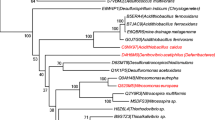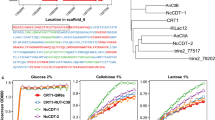Abstract
Sucrose is the most abundant disaccharide in the environment because of its origin in higher plant tissues, and many Eubacteria possess catalytic enzymes, such as the sucrose-6-phosphate hydrolases and sucrose phosphorylases, that enable them to metabolise this carbohydrate in a regulated manner. This review describes the range of gene architecture, uptake systems, catabolic activity and regulation of the sucrose-utilisation regulons that have been reported in the Eubacteria to date. Evidence is presented that, although there are many common features to these gene clusters and high conservation of the proteins involved, there has been a certain degree of gene shuffling. Phylogenetic analyses of these proteins supports the hypothesis that these clusters have been acquired through horizontal gene transfer via mobile elements and transposons, and this may have enabled the recipient bacteria to colonise sucrose-rich environmental niches.



Similar content being viewed by others
References
Barrangou R, Altermann E, Hutkins R, Cano R, Klaenhammer TR (2003) Functional and comparative genomic analyses of an operon involved in fructooligosaccharide utilization by Lactobacillus acidophilus. Proc Natl Acad Sci USA 100:8957–8962
Blatch GL, Woods DR (1991) Nucleotide sequence and analysis of the Vibrio alginolyticus scr repressor-encoding gene (scrR). Gene 101:45–50
Blatch GL, Woods DR (1993) Molecular characterization of a fructanase produced by Bacteroides fragilis BF-1. J Bacteriol 175:3058–3066
Bogs J, Geider K (2000) Molecular analysis of sucrose metabolism of Erwinia amylovora and influence on bacterial virulence. J Bacteriol 182:5351–5358
Broek LAM van den, van Boxtel EL, Kievit RP, Verhoef R, Beldman G, Voragen AGJ (2004) Physico-chemical and transglucosylation properties of recombinant sucrose phosphorylase from Bifidobacterium adolescentis DSM20083. Appl Microbiol Biotechnol 65:219–227
Brückner R, Titgemeyer F (2002) Carbon catabolite repression in bacteria: choice of the carbon source and autoregulatory limitation of sugar utilization. FEMS Microbiol Lett 209:141–148
Brückner R, Wagner E, Gotz F (1993) Characterization of a sucrase gene from Staphylococcus xylosus. J Bacteriol 175:851–857
Busby S, Ebright RH (1999) Transcription activation by catabolite activator protein (CAP). J Mol Biol 293:199–213
Davison SP, Santangelo JD, Reid SJ, Woods DR (1995) A Clostridium acetobutylicum regulator gene (regA) affecting amylase production in Bacillus subtilis. Microbiol 141:989–996
Deutscher J, Galinier A, Martin-Verstraete I (2002) Carbohydrate uptake and metabolism. In: Sonenshein AL, Hoch JA, Losick R (eds) Bacillus subtilis and its closest relatives: from genes to cells. ASM, Washington, pp 129–150
Dols M, Chraibi W, Remaud-Simeon M, Lindley ND, Monsan PF (1997) Growth and energetics of Leuconostoc mesenteroides NRRL B-1299 during metabolism of various sugars and their consequences for dextransucrase production. Appl Environ Microbiol 21:59–65
Doolittle WF (1999) Phylogenetic classification and the universal tree. Science 284:2124–2128
Egeter O, Brückner R (1996) Catabolite repression mediated by the catabolite control protein CcpA in Staphylococcus xylosus. Mol Microbiol 21:739–749
Fitzgerald JR, Sturdevant DE, Mackie SM, Gill SR, Musser JM (2001) Evolutionary genomics of Staphylococcus aureus: insights into the origin of methicillin-resistant strains and the toxic shock syndrome epidemic. Proc Natl Acad Sci USA 98:8821–8826
Fouet A, Klier AF, Rapoport G (1986) Nucleotide sequence of the sucrase gene of Bacillus subtilis. Gene 45:221–225
Fournier P, de Ruffray P, Otten L (1994) Natural instability of Agrobacterium vitis Ti plasmid due to unusual duplication of a 2.3-kb DNA fragment. Mol Plant–Microb Interact 7:164–172
Gering M, Brückner R (1996) Transcriptional regulation of the sucrase gene of Staphylococcus xylosus by the repressor ScrR. J Bacteriol 178:462–469
Henkin TM, Grundy FJ, Nicholson WL, Chambliss GH (1991) Catabolite repression of alpha-amylase gene expression in Bacillus subtilis involves a trans-acting gene product homologous to the Escherichia coli lacI and galR repressors. Mol Microbiol 5:575–584
Henrissat B, Bairoch A (1996) Updating the sequence-based classification of glycosyl hydrolases. Biochem J 316:695–696
Hiratsuka K, Wang B, Sato Y, Kuramitsu H (1998) Regulation of sucrose-6-P hydrolase activity in Streptococcus mutans: characterization of the scrR gene. Infect Immun 66:3736–3743
Hochhut B, Jahreis K, Lengeler JW, Schmid K (1997) CTnscr94, a conjugative transposon found in enterobacteria. J Bacteriol 179:2097–2102
Hueck CJ, Hillen W (1995) Catabolite repression is Bacillus subtilis: a global regulatory mechanism for the Gram-positive bacteria? Mol Microbiol 15:395–401
Jahreis K, Bentler L, Bockmann J, Hans S, Meyer A, Siepelmeyer J, Lengeler JW (2002) Adaptation of sucrose metabolism in the Escherichia coli wild-type strain EC3132. J Bacteriol 184:5307–5316
Kawasaki H, Nakamura N, Ohmori M, Sakai T (1996) Cloning and expression in E. coli of sucrose phosphorylase gene from Leuconostoc mesenteroides no. 165. Biosci Biotechnol Biochem 60:322–324
Kim M, Kwon T, Lee HJ, Kim KH, Chung DK, Ji GE, Byeon ES, Lee JH (2003) Cloning and expression of sucrose phosphorylase gene from Bifidobacterium longum in E. coli and characterization of the recombinant enzyme. Biotechnol Lett 25:1211–1217
Kitaoka M, Hayashi K (2002) Carbohydrate-processing phosphorolytic enzymes. Trends Glycosci Glycotechnol 14:35–50
Koga T, Nakamura K, Shirokane Y, Mizusawa K, Kitao S, Kikuchi M (1991) Purification and some properties of sucrose phosphorylase from Leuconostoc mesenteroides. Agric Biol Chem 55:1805–1810
Laere KMJ van, Hartemink R, Bosveld M, Schols HA, Voragen AGJ (2000) Fermentation of plant cell wall derived polysaccharides and their corresponding oligosaccharides by intestinal bacteria. J Agric Food Sci 48:1644–1652
Lengeler JW, Jahreis K, Wehmeier UF (1994) Enzymes II of the phosphoenolpyruvate-dependent phosphotransferase systems: their structure and function in carbohydrate transport. Biochim Biophys Acta 1188:1–28
Liebl W, Brem D, Gotschlich A (1998) Analysis of the gene for beta-fructosidase (invertase, inulinase) of the hyperthermophilic bacterium Thermotoga maritima, and characterisation of the enzyme expressed in Escherichia coli. Appl Microbiol Biotechnol 50:55–64
Luesink EJ, Marugg JD, Kuipers OP, de Vos WM (1999) Characterisation of the divergent sacBK and sacAR operons, involved in sucrose utilisation in Lactococcus lactis. J Bacteriol 181:1924–1926
Moreno MS, Schneider BL, Maile RR, Weyler W, Saier MH Jr (2001) Catabolite repression mediated by the CcpA protein in Bacillus subtilis: novel modes of regulation revealed by whole-genome analyses. Mol Microbiol 39:1366–1381
Naumoff DG, Livshits VA (2001) Molecular structure of the Lactobacillus plantarum sucrose utilization locus: comparison with Pediococcus pentosaceus. Mol Biol 35:15–22
Nesbo CL, Nelson KE, Doolittle WF (2002) Suppressive subtractive hybridization detects extensive genomic diversity in Thermotoga maritima. J Bacteriol 184:4475–4488
Nolling J, Breton G, Omelchenko MV, Makarova KS, Zeng Q, Gibson R, Lee HM, Dubois J, Qiu D, Hitti J, Wolf YI, Tatusov RL, Sabathe F, Doucette-Stamm L, Soucaille P, Daly MJ, Bennett GN, Koonin EV, Smith DR (2001) Genome sequence and comparative analysis of the solvent-producing bacterium Clostridium acetobutylicum. J Bacteriol 183:4823–4838
Ochman H, Lawrence JG, Groisman EA (2000) Lateral gene transfer and the nature of bacterial innovation. Nature 405:299–304
Parche S, Burkovski A, Sprenger GA, Weil B, Kramer R, Titgemeyer, F (2001) Corynebacterium glutamicum: a dissection of the PTS. J Mol Microbiol Biotechnol 3:423–428
Pareira Y, Petit-Glatron M, Chambert R (2001) yveB, encoding endolevanase LevB, is part of the sacB–yveB–yveA levansucrase tricistronic operon in B. subtilis. Microbiol 147:3413–3419
Paulsen IT (1996) Carbon metabolism and its regulation in Streptomyces and other high GC Gram-positive bacteria. Res Microbiol 147:535–541
Rauch PJG, de Vos WM (1992) Transcriptional regulation of the Tn5276-located Lactococcus lactis sucrose operon and characterisation of the sacA gene encoding sucrose-6-phosphate hydrolase. Gene 121:55–61
Rauch PJG, Beerthuyzen MM, de Vos WM (1994) Distribution and evolution of nisin–sucrose elements in Lactococcus lactis. Appl Environ Microbiol 60:1798–1804
Reid SJ (2004) Genetic organisation and regulation of hexose and pentose utilisation in the Clostridia. In: Duerre P (ed) The Clostridia. CRC, Boca Raton (in press)
Reid SJ, Rafudeen MS, Leat NG (1999) The genes controlling sucrose utilization in Clostridium beijerinckii NCIMB 8052 constitute an operon. Microbiol 145:1461–1471
Reizer J, Romano AH, Deutscher J (1993) The role of phosphorylation of HPr, a phosphocarrier protein of the phosphotransferase system, in the regulation of carbon metabolism in Gram-positive bacteria. J Cell Biol Chem 51:19–24
Russell RR, Mukasa H, Shimamura A, Ferretti JJ (1988) Streptococcus mutans gtfA gene specifies sucrose phosphorylase. Infect Immun 56:2763–2765
Russell RR, Aduse-Opoku J, Sutcliffe IC, Tao L, Ferretti JJ (1992) A binding protein-dependent transport system in Streptococcus mutans responsible for multiple sugar metabolism. J Biol Chem 267:4631–4637
Rutberg B (1997) Antitermination of transcription of catabolic operons. Mol Microbiol 23:413–421
Saier MH (1998) Molecular phylogeny as a basis for the classification of transport proteins from bacteria, archaea and eukarya. Adv Microbiol Physiol 40:81–136
Saier MH, Fagan MJ, Hoischen C, Reizer J (1993) Transport mechanisms. In: Sonenshein AL, Hoch JA, Losick R (eds) Bacillus subtilis and other Gram-positive bacteria: biochemistry, physiology and molecular genetics. ASM, Washington, pp 133–156
Saier MH, Chauvaux S, Deutscher J, Reizer J, Ye J-J (1995) Protein phosphorylation and regulation of carbon metabolism in Gram-negative versus Gram-positive bacteria. Trends Biochem Sci 20:267–271
Schell MA, Karmirantzou M, Snel B, Vilanova D, Berger B, Pessi G, Zwahlen M, Desiere F, Bork P, Delley M, Pridmore RD, Arigoni F (2002) The genome sequence of Bifidobacterium longum reflects its adaptation to the human gastrointestinal tract. Proc Natl Acad Sci USA 99:14422–14427
Schmid K, Ebner R, Altenbuchner J, Schmitt R, Lengeler JW (1988) Plasmid-mediated sucrose metabolism in E. coli K12: mapping of the scr genes of pUR400. Mol Microbiol 2:1–8
Shimizu T, Ohtani K, Hirakawa H, Ohshima K, Yamashita A, Shiba T, Ogasawara N, Hattori M, Kuhara S, Hayashi H (2002) Complete genome sequence of Clostridium perfringens, an anaerobic flesh-eater. Proc Natl Acad Sci USA 99:996–1001
Song EK, Kim H, Sung HK, Cha J (2002) Cloning and characterization of a levanbiohydrolase from Microbacterium laevaniformans ATCC 15953. Gene 291:45–55
Sprogoe D, van den Broek LA, Mirza O, Kastrup JS, Voragen AG, Gajhede M, Skov LK (2004) Crystal structure of sucrose phosphorylase from Bifidobacterium adolescentis. Biochemistry 43:1156–1162
Steinmetz M (1993) Carbohydrate catabolism: pathways, enzymes, genetic regulation, and evolution. In: Sonenshein AL (ed) Bacillus subtilis and other Gram-positive bacteria: biochemistry, physiology and molecular genetics. ASM, Washington, pp 157–170
Sutrina SI, Reddy P, Saier MH, Reizer J (1990) The glucose permease of Bacillus subtilis is a single polypeptide chain that functions to energize the sucrose permease. J Biol Chem 265:18581–18589
Tangney M, Mitchell WJ (2000) Analysis of a catabolic operon for sucrose transport and metabolism in Clostridium acetobutylicum ATCC 824. J Mol Microbiol Biotechnol 2:71–80
Thompson JD, Higgins DG, Gibson TJ (1994) CLUSTAL W: improving the sensitivity of progressive multiple sequence alignment through sequence weighting, position-specific gap penalties and weight matrix choice. Nucleic Acids Res 22:4673–4680
Titgemeyer F, Reizer J, Reizer A, Saier MH (1994) Evolutionary relationships between sugar kinases and transcriptional repressors in bacteria. Microbiology 140:2349–2354
Titgemeyer F, Jahreis K, Ebner R, Lengeler JW (1996) Molecular analysis of the scrA and scrB genes from Klebsiella pneumoniae and plasmid pUR400, which encode the sucrose transport protein Enzyme II(Scr) of the phosphotransferase system and a sucrose-6-phosphate invertase. Mol Gen Genet 250:197–206
Tortosa P, Declerck N, Dutartre H, Lindner C, Deutscher J, Le Coq D (2001) Sites of positive and negative regulation in the Bacillus subtilis antiterminators LicT and SacY. Mol Microbiol 41:1381–1383
Trethewey RN, Fernie AR, Bachmann A, Fleicscher-Notter H, Geigenberger P, Willmitzer L (2001) Expression of a bacterial phosphorylase in potato tubers results in a glucose independent induction of glycolysis. Plant Cell Environ 24:357–365
Trindade MI, Abratt VR, Reid SJ (2003) Induction of the sucrose utilisation genes from Bifidobacterium lactis by sucrose and raffinose. Appl Environ Microbiol 69:24–32
Weickert MJ, Adhya S (1992) The family of bacterial regulators homologous to Gal and Lac repressors. J Biol Chem 267:15869–15874
Author information
Authors and Affiliations
Corresponding author
Electronic Supplementary Material
Rights and permissions
About this article
Cite this article
Reid, S.J., Abratt, V.R. Sucrose utilisation in bacteria: genetic organisation and regulation. Appl Microbiol Biotechnol 67, 312–321 (2005). https://doi.org/10.1007/s00253-004-1885-y
Received:
Revised:
Accepted:
Published:
Issue Date:
DOI: https://doi.org/10.1007/s00253-004-1885-y




